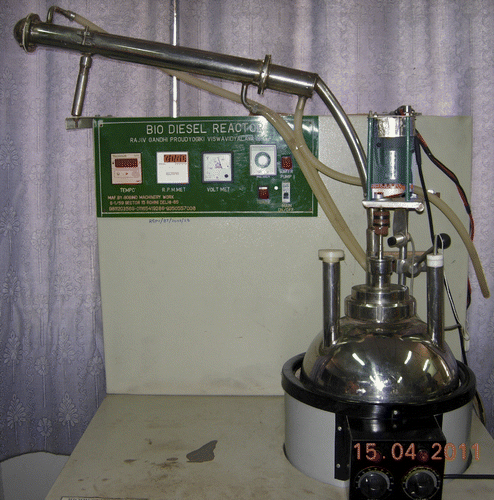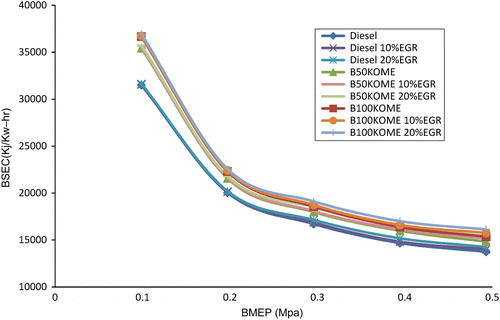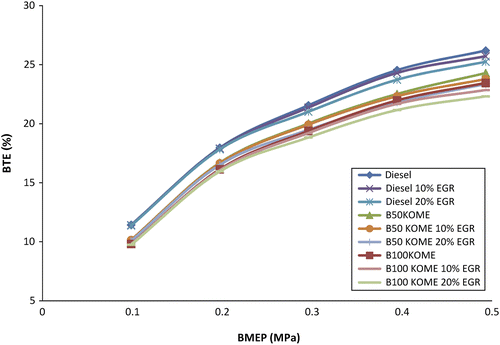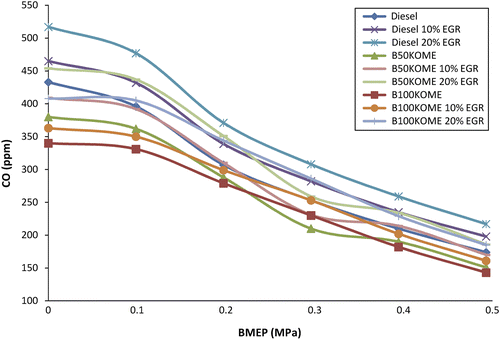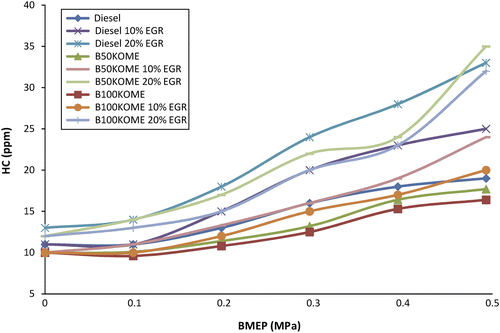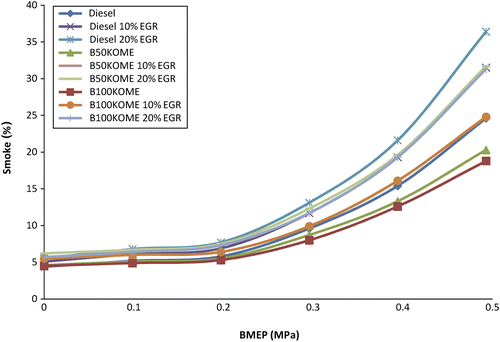Abstract
Karanja oil methyl ester (KOME), a biodiesel prepared from Karanja oil, a potential source of non-edible oil in India and a prospective alternative to the diesel fuel, shows comparable performance and considerable reduction in emissions except NOx. Exhaust gas recirculation (EGR) is a popular method of reducing the NOx emission. The aim of this experimental work was to study the potential of the cooled EGR in a direct injection compression ignition engine operating with the KOME and its blend. The study was conducted with the different EGR rates. Performance and emission parameters were compared by using diesel, KOME and its blend employing EGR and with the same fuels without EGR. The study also differentiates the effect of EGR on KOME and its blend with the neat diesel. The effect of EGR was found to be slightly higher for KOME biodiesel and its blend than for neat diesel. Increased NOx emission using KOME biodiesel was also found to be reduced by using EGR.
Introduction
India's fast growing economy depends heavily on oil. The current requirements hover around 146 million metric tons (MMT), whereas the domestic production is around 34 MMT (Ramana and Ramprasad Citation2010). The import of such a huge difference in the supply is a great concern for a nation. The most feasible way to meet this growing requirement is by replacing these fossil fuels by utilising renewable alternative fuels. The alternative fuels at the same time should meet the stringent emission norms.
Biodiesel is an alternative to petroleum-based fuels, and is the mono-alkyl esters of the edible/non-edible oils or animal fats. The problems faced with raw vegetable oils as fuels are poor atomisation due to their high viscosity, severe engine deposits, injector coking and piston ring sticking and incomplete combustion leading to higher smoke density (Peterson and Auld Citation1991). Transesterification of these vegetable oils separates the glycerine with oil and replaces it with radicals from the alcohol used for the conversion process. This process decreases the viscosity of the oil (Van-Gerpen et al. Citation1997). These esters are promising alternative fuels for compression ignition engines and are called biodiesel. Studies show that the performance of the diesel engine operated with the biodiesel fuel is almost similar to that of diesel fuel. Its efficiency is found to be similar or better than that of the diesel fuel. The carbon monoxide (CO), hydrocarbon (HC) and smoke emission observed with the biodiesel is lesser than that of the diesel fuel. The NOx emission is found to be higher for the biodiesel fuel (Buyukkaya Citation2010; Bueno, Velásquez, and Milanez Citation2011; Gravalos et al. Citation2009; Venkanna and Reddy Citation2011; Behçet Citation2011; Shirsath et al. Citation2012).
The NOx increase may limit the use of biodiesel, and is therefore, a significant barrier to the market expansion. Exhaust gas recirculation (EGR) is one of the effective methods for reducing the NOx (Nabi, Rahman, and Akhter Citation2009; Zheng, Reader, and Hawley Citation2004; Ghazikhani, Feyz, and Joharchi. Citation2010; Peng et al. Citation2008; Abd-Alla et al. Citation2001; Ramadhas, Muraleedharan, and Jayaraj Citation2008). The objective of this study was to evaluate the effect of using EGR in biodiesel-fuelled engine.
Production of biodiesel from Karanja oil
Karanja tree shown in Figure is amongst the number of non-edible seed sources available for the production of biodiesel. Karanja is believed to have originated in India and distributed throughout the country from the Ravi River eastward in the hills of South India up to the elevation of about 1200 metres and in the Himalayas up to about 610 metres. It is widely grown from tropical dry to subtropical dry forest life zones. It is a widely adaptable tree that grows under the wide range of temperature from 5 to 50°C and that has an average rainfall of 600–2500 millimetres (Kureel et al. Citation2008). The production potential of Karanja is 70,000 metric tonnes annually (Sahoo et al. Citation2007).
The production of biodiesel from Karanja oil involves of heating of 10 litres Karanja oil at 60°C in a reactor as shown in Figure with a capacity of 10 litres. A mixture of 40% methanol and 0.75% potassium hydroxide is added to the oil and stirred for 1.3 h. The two distinct layers of Karanja oil methyl ester (KOME) and glycerol formed were then allowed to settle. Once the heavy black glycerol layer settled down, the methyl ester layer formed at the upper part of the reactor. Glycerol followed by KOME separated from the bottom part of the reactor through a valve. The yield of KOME was approximately 88%. After that, a gentle washing process was carried out to remove some unreacted remainder of methanol and catalyst using heated distilled water, which if not removed can react, and damage storing and fuel carrying parts. After washing, two distinct layers formed at the bottom layer having water and impurities settled down and removed. The upper layer consists of biodiesel. A heating process at about 60°C was applied for removing the water contained in the KOME, and was finally, left to cool down.
NOx formation and control
NOx can be formed by two major pathways during diesel fuel combustion: the Zeldovich (thermal) mechanism and the Fenimore (prompt) mechanism. The rate of the Zeldovich reactions depends on the flame temperature, whereas the Fenimore pathway is the complex one. In the Fenimore mechanism, free radicals formed from the fuel react with N2 to eventually form NOx. This takes place very early in the combustion process, and is partly dependent on the fuel radical concentration and on how it is established (Miller and Bowman Citation1989). The boundary surface of the fine fuel droplets comes in contact with excess nitrogen, and oxygen present in the air at a temperature high enough to form NOx leads to the formation of NOx.
Different methods are available for the reduction of NOx. The cetane improvers are capable of reducing NOx, but the addition of cetane improvers increases the cost of fuel and the possibilities of auto-oxidation. Retarded injection is the method used for reducing NOx for compression ignition engines, which leads to an increase in brake-specific fuel consumption (BSFC) and emissions. Water injection leads to corrosion and increase in the weight due to water storage (Pradeep and Sharma Citation2007).
The EGR is one of the methods used in modern diesel engine to reduce NOx emission. The EGR leads to the following effects.
Thermal effect: The recirculation of the exhaust gases into the combustion chamber leads to an increase in the specific heat capacity of the mixture and hence the lower gas temperature rise for the same heat release in the combustion chamber.
Dilution effect: The fresh air entered into the cylinder is replaced partially by the exhaust gas coming out of the cylinder. This leads to replacement of oxygen and nitrogen present in the air by the carbon dioxide and water molecules of the exhaust gas.
Chemical effect: The recirculated water and carbon dioxide are dissociated during combustion to modify the combustion process and the NOx formation. In particular, the endothermic dissociation of H2O results in a decrease of the flame temperature (Maiboom, Tauzia, and Hétet Citation2008).
Experimental set-up and test procedure
The experimental set-up shown in Figure consists of four cylinders, four strokes, a direct injection diesel engine and an engine test bed with hydraulic dynamometer. The specifications of the test engine are given in Table . The test bed contains instruments for measuring various parameters such as engine load, airflow by anemometer and gas temperatures by K-type thermocouples. The fuel consumption was determined by weighing the fuel on an electronic scale. For the analysis of the exhaust, Eurotron green line gas analyser and AVL 437 smoke meter were used. The CO and HC were measured by the principle of Non dispersive infra-red (NDIR) detection and NOx by electrochemical sensors.
Table 1 Test engine specification.
Table 2 Fuel properties of diesel and KOME.
The exhaust gases coming out from the engine cylinder were partly recirculated into the intake manifold by creating an external EGR pipeline. An EGR cooler was used to reduce the exhaust gas temperature using water, and a valve was placed in the EGR route to control the flow. An air damping box was placed in this route to compensate the pulsating nature of the exhaust gases. The gases before entering the cylinder were then passed to particulate filter containing steel wool to reduce the particulates entering into the combustion chamber. The percentage of EGR is calculated based on the following equation:
The test was carried out at a constant 2000 rpm by varying the load and the percentage of EGR. The performance parameters tested were brake thermal efficiency (BTE), brake-specific energy consumption (BSEC), CO, HC, NOx and smoke emissions. The base line data were prepared by using diesel as fuel. The KOME was blended with diesel fuel in the proportion of 50 and 100%. The fuel properties are given in Table .
Results and discussion
Brake-specific energy consumption
Figure shows the variation in BSEC with the brake mean effective pressure (BMEP). The BSFC is not a reliable criterion for comparing the two fuels of different calorific values. Hence, the BSEC is more reliable for this purpose, which takes into account the calorific value of fuel.
The values of BSEC were decreased with the increase in load. The possible reason could be the reduction in losses at higher loads. The values of BSEC were found to increase with an increase in the percentage of KOME blend. The possible reason of higher energy consumption of higher blends could be the higher viscosity, density and lower volatility, which affects the formation of mixture and leads to more dominating diffusion combustion phase. Due to the higher viscosity and density, the amount of fuel injected was higher than the diesel fuel. The BSEC of 50 and 100% blends showed an average increase of 12.44 and 8.91% in comparison with neat diesel fuel, whereas the average increase of the BSFC was found to be 27.73 and 15.31%, respectively. This indicates the lower increase in energy consumption of KOME blends in comparison with fuel consumption.
The BSEC was found to be lowest for the fuels without EGR. The increased percentage of EGR slightly increased the BSEC especially at medium and higher load. The increase in BSEC may be attributed to the diluents admission leading to reduction in burning rate, in order to make the combustion complete and stable.
It was found that the different blends showed different responses to BSEC with EGR. The diesel fuel, B50 and B100 KOME showed an average increase of 0.85, 0.8 and 1.1% increased BSEC with the 10% EGR in comparison with the same fuel without EGR. This result showed that the 50% KOME showed slightly lower response in increasing the BSEC.
The percentage change in BSEC with 20% EGR is slightly higher. The diesel fuel, B50 and B100 KOME showed an average increase of 2.18, 2.35 and 2.74% in comparison with the same fuel without EGR. The B100 KOME showed slightly higher response in increasing the BSEC.
However, when compared with the result of BSEC of B50 and B100 KOME using the 10% of EGR with the neat diesel fuel, an average increase of 9.78 and 13.7% was observed. The same comparison with the 20% of EGR showed an average increase of 11.5 and 15.5%, respectively.
Brake thermal efficiency
Thermal efficiency is the ratio of engine's output power to the fuel energy. The fuel energy is the product of mass flow rate of fuel and calorific value which is the BSEC; hence, BTE indicates the inverse of BSEC. Figure shows the variation in BTE with the BMEP. Increasing the load increases the thermal efficiency which can be due to reduction in heat losses at higher load.
The KOME and its blend showed lower efficiency than the neat diesel fuel. The B50 and B100 KOME showed average reduction of 8.16 and 11% in comparison with neat diesel fuel. This reduction can be attributed to the lower calorific value of the KOME, which leads to an increase in the specific fuel consumption. The increase in fuel consumption requires the increased volume and duration of fuel injection. Since the fuel was injected at a fixed injection time, more fuel was injected during the expansion stroke and leads to more diffusion combustion.
The result showed that the EGR tends to reduce the thermal efficiency of all the fuels. The possible reason could be the reduction in the flame temperature due to diluents admission resulting in the reduction of BTE. Use of 10% EGR leads to an average reduction in the thermal efficiency of neat diesel, B50 and B100 KOME, which was found to be 0.83, 0.78 and 1.1% in comparison with the same fuel without EGR. The 20% of EGR leads to an average reduction in the thermal efficiency of neat diesel, B50 and B100 KOME, which was found to be 2.11, 2.28 and 2.64% in comparison with the same fuel without EGR. The possible reason of the reduced thermal efficiency can be the reduction of the fresh oxygen, available for the combustion and the lowering of the average combustion temperature due to the EGR.
The BTE of B50 and B100 KOME with 10% of EGR when compared with the neat diesel showed an average reduction of 8.9 and 12%, whereas 20% of EGR showed an average reduction of 10.27 and 13.4%, respectively.
CO emission
Figure shows the variation in the CO emission with the BMEP. Result showed reduction in CO emission with the increasing load. This trend is different from the study of most of the researchers (Baiju, Naik, and Das Citation2009; Godiganur, Murthy, and Reddy 2009; 2010; Ramadhas, Muraleedharan, and Jayaraj. Citation2005), a the similar trend was observed by few (Mani, Nagarajan, and Sampath Citation2010).
The CO emission of neat diesel fuel was from 433 to 174 ppm. The KOME showed an average reduction of 14.54%, whereas the 50% blend showed an average reduction of 11.13% in emission compared with diesel fuel. The reduction in CO emission may be attributed to the oxygen molecules available in the KOME, which promotes the conversion of CO into CO2.
The EGR tends to increase the CO emission. The effect of diluents admission is to lower the oxygen concentration, which leads to retard the reaction rate. This could lead to increase the CO emission. The neat diesel, 50% blend and neat KOME when subjected to 10% of EGR showed an average CO increase of 10.68, 9.79 and 8.87% compared with the same fuel without EGR. This indicates that the CO response of neat KOME to 10% EGR is lesser than that of the diesel fuel. CO emissions of the same fuels when subjected to 20% of EGR showed an average increase of 21.75, 21.96 and 24.2%, respectively, compared with the same fuels without EGR. This indicates that the CO emission of KOME blends to 20% EGR is more responsive than that of the neat diesel fuel.
The CO emission depends on the air fuel ratio, while applying EGR, BSFC increases and air fuel ratio decreases, which in turn increases CO emission. The percentage increase of CO of KOME and its blend was lower at low EGR rate, which may be due to the presence of substantial amount of oxygen in the KOME. At higher EGR rate, recirculating the exhaust of KOME which contains higher amount of CO2 leads to more dilution effect. This could be the reason of higher percentage increase of CO of KOME and its blend.
However, the CO emission of B50 and B100 with the 10% of EGR showed an average reduction of 2.44 and 6.94% compared with that of the diesel fuel. Increasing the EGR to 20% results in an average increase of 8.37 and 6.16%, respectively.
HC emission
Figure shows the variation in HC emission with BMEP. It was observed that increasing the load increases the HC emission. The blending of KOME with diesel fuel decreases the HC emission. The 50 and 100% blend of KOME with the diesel fuel showed an average reduction of 10.5 and 14.9%, respectively, compared with diesel fuel. The reduction in HC emission is the indicative of cleaner combustion, which could be due to the existence of oxygen in the KOME fuel and with high combustion temperature, makes the HC oxidation easier.
The application of EGR was found to increase the HC emission. Employing EGR in an engine reduces the oxygen in the combustion chamber and reduces the oxidation rate which is responsible for the increase in the HC emission. It was observed that the percentage increase in HC emission due to EGR is higher at higher loads. The diesel, B50 and B100 KOME showed an average increase of 16.6, 16.4 and 11.4% to 10% of EGR compared with the same fuel without EGR. The percentage increase of HC emission due to 10% of EGR was found to be lower for the neat KOME. The same fuels showed an average increase of 43.9, 53.1 and 50% to 20% of EGR, compared with fuels without EGR. The result indicates the higher percentage increase in the HC emission of the biodiesel and its blend for the 20% of EGR.
When the results of HC emission of KOME were compared with that of the neat diesel fuel, it was observed that the 10% EGR showed an average increase of 4.18% with B50 and an average reduction of 5.4% with B100 KOME, whereas 20% of EGR showed an average increase of 37 and 27.3% with the B50 and B100 KOME, respectively.
NOx emission
Figure shows the variation in NOx emission with the BMEP. The result indicated that the NOx increases with the increase in load. The KOME and its blend showed higher NOx emission than the diesel fuel. The average percentage increase in NOx emission was found to be 11.1 and 18.1% for the B50 and B100 KOME compared with that of neat diesel fuel. NOx formation depends heavily on the in-cylinder temperature, and increase in the in-cylinder temperature leads to more formation of NOx. Increasing the load increases the fuel air ratio; similarly increasing the KOME proportion increases the oxygen contents, which leads to increase in the formation of NOx.
NOx emission was found to be decreased when operated with EGR. Increasing the EGR results in the replacement of oxygen, by the water and carbon dioxide, results in the reduction of in-cylinder temperature. The effect of 10% of EGR was to lower the average NOx emission by 19.9, 19.7 and 20.9% to diesel, B50 and B100 KOME, respectively, when compared with the same fuel without EGR. The same fuels when subjected to 20% of EGR lead to an average reduction of 31.9, 29.3 and 34.9% in NOx compared with the same fluids without EGR.
This indicates that the NOx response of diesel, KOME and its blends to 10% of EGR is almost same, whereas the neat KOME showed slightly higher response to 20% of EGR. This may be due to higher BSFC of biodiesel results in higher recirculation of water particles, and lowering the flame temperature results in slightly higher reduction of NOx.
The comparison of NOx emission of B50 and B100 KOME using 10% EGR with the neat diesel fuel showed an average reduction of 11 and 6.56%, whereas the 20% of EGR showed an average reduction of 23.6 and 23.2%, respectively.
Smoke emission
Figure shows the variation in smoke emission with the BMEP. The result showed an increase in smoke emission with the increase in load. Higher rate of increase in smoke emission was found at higher loads. This may be due to the reason that the charge becomes more rich in fuel at higher load. The KOME and its blends due to oxygen enrichment showed slight reduction in smoke emission. The B50 and B100 KOME showed an average reduction of 7.17 and 11.8% in smoke emission compared with neat diesel fuel.
The smoke emission was found to be increased with an increase in the EGR. This could be attributed to the reduction in the fresh oxygen available, outside the combustion chamber to premix with the fuel injected and inside the chamber to oxidise the formed soot. The 10% of EGR results in an average increase of 21.2, 24.3 and 24.8% when applied on diesel, B50 and B100 KOME, and compared with the same fuels without EGR. The same fuels when subjected to 20% of EGR showed an average increase of 35.5, 41.2 and 43.5%, respectively. It was observed that the response of smoke emission of KOME fuel is slightly higher than the diesel fuel when subjected to the EGR.
The smoke emission of B50 and B100 KOME with 10% of EGR when compared with the neat diesel fuel showed an average increase of 14.95 and 9.86%, and when compared with the 20% of EGR showed an average increase of 30.55 and 25.49%, respectively.
Conclusion
In this study, experiments were conducted with a direct injection, naturally aspirated diesel engine to investigate the performance and emission of the biodiesel and its blends prepared from Karanja oil. The effect of cooled EGR on the biodiesel and its blends was compared with the diesel fuel. The major conclusion is as follows:
The KOME and its blends showed reduction in CO, HC and smoke emission with a penalty of increase in NOx emission, energy consumption and reduction in BTE.
The recirculation of the cooled exhaust showed reduction in NOx emission with a slight penalty on HC, CO and smoke emissions.
The effect of EGR was found to be increased with the increased load.
The use of 10% of EGR with the 50 or 100% KOME was found to reduce the exhaust emissions compared with neat diesel fuel.
Increasing the percentage of EGR from 10 to 20 results in slightly higher percentage increase in HC than the decrease in NOx.
The KOME and its blends were found to be more responsive to the EGR than the neat diesel fuel.
REFERENCES
- Abd-Alla, G. H., H. A. Soliman, O. A. Badr, and M. F. Abd-Rabbo.2001. “Effects of Diluent Admissions and Intake Air Temperature in Exhaust Gas Recirculation on the Emissions of an Indirect Injection Dual Fuel Engine.” Energy Conversion and Management42 (8): 1033–1045.
- Abu-Hamdeh, N. H.2003. “Effect of Cooling the Recirculated Exhaust Gases on Diesel Engine Emissions.” Energy Conversion and Management44 (19): 3113–3124.
- Baiju, B., M. K.Naik, and L. M.Das. 2009. “A Comparative Evaluation of Compression Ignition Engine Characteristics Using Methyl and Ethyl Esters of Karanja Oil.” Renewable Energy34 (6): 1616–1621.
- Behçet, R.2011. “Performance and Emission Study of Waste Anchovy Fish Biodiesel in a Diesel Engine.” Fuel Processing Technology92 (6): 1187–1194.
- Bueno, A. V., J. A.Velásquez, and L. F.Milanez. 2011. “Heat Release and Engine Performance Effects of Soybean Oil Ethyl Ester Blending into Diesel Fuel.” Energy36 (6): 3907–3916.
- Buyukkaya, E.2010. “Effects of Biodiesel on a DI Diesel Engine Performance, Emission and Combustion Characteristics.” Fuel89 (10): 3099–3105.
- Ghazikhani, M., M. E.Feyz, and A.Joharchi. 2010. “Experimental Investigation of the Exhaust Gas Recirculation Effects on Irreversibility and Brake Specific Fuel Consumption of Indirect Injection Diesel Engines.” Applied Thermal Engineering30 (13): 1711–1718.
- Godiganur, S., Ch. S.Murthy, and R. P.Reddy. 2009. “6BTA 5.9 G2-1 Cummins Engine Performance and Emission Tests Using Methyl Ester Mahua (Madhuca indica) Oil/Diesel Blends.” Renewable Energy34 (10): 2172–2177.
- Godiganur, S., Ch. S.Murthy, and R. P.Reddy. 2010. “Performance and Emission Characteristics of a Kirloskar HA394 Diesel Engine Operated on Fish Oil Methyl Esters.” Renewable Energy35 (2): 355–359.
- Gravalos, I., T. Gialamas, Z. Koutsofitis, D. Kateris, P. Xyradakis, Z. Tsiropoulos, and G. Lianos.2009. “Comparison of Performance Characteristics of Agricultural Tractor Diesel Engine Operating on Home and Industrially Produced Biodiesel.” International Journal of Energy Research33 (12): 1048–1058.
- Kureel, R. S., C. B. Singh, A. K. Gupta, and A. Pandey.2008. “Karanja a Potential Source of Biodiesel.” Report National Oilseed and Veetable Oils Development Board. http://www.novodboard.com/Karanja%20English.pdf.
- Maiboom, A., X.Tauzia, and J. F.Hétet. 2008. “Experimental Study of Various Effects of Exhaust Gas Recirculation (EGR) on Combustion and Emissions of an Automotive Direct Injection Diesel Engine.” Energy33 (1): 22–34.
- Mani, M., G.Nagarajan, and S.Sampath. 2010. “An Experimental Investigation on a DI Diesel Engine Using Waste Plastic Oil with Exhaust Gas Recirculation.” Fuel89 (8): 1826–1832.
- Miller, J. A., and C. T.Bowman. 1989. “Mechanism and Modeling of Nitrogen Chemistry in Combustion.” Progress in Energy and Combustion Science15 (4): 287–338.
- Nabi, M. N., M. M.Rahman, and M. S.Akhter. 2009. “Biodiesel from Cotton Seed Oil and Its Effect on Engine Performance and Exhaust Emissions.” Applied Thermal Engineering29 (11–12): 2265–2270.
- Peng, H., Y. Cui, L. Shi, and K. Deng.2008. “Effects of Exhaust Gas Recirculation (EGR) on Combustion and Emissions during Cold Start of Direct Injection (DI) Diesel Engine.” Energy33 (3): 471–479.
- Peterson, C. L., and D. L.Auld. 1991. “Technical Overview of Vegetable Oil as a Transportation Fuel.” Solid Fuel Conversion for the Transportation Sector12: 45–54.
- Pradeep, V., and R. P.Sharma. 2007. “Use of HOT EGR for NOx Control in a Compression Ignition Engine Fuelled with Bio-Diesel from Jatropha Oil.” Renewable Energy32 (7): 1136–1154.
- Ramadhas, A. S., C.Muraleedharan, and S.Jayaraj. 2005. “Performance and Emission Evaluation of a Diesel Engine Fueled with Methyl Esters of Rubber Seed Oil.” Renewable Energy30 (12): 1789–1800.
- Ramadhas, A. S., C.Muraleedharan, and S.Jayaraj. 2008. “Reduction in Exhaust Gas Temperature of Biodiesel Fueled Engine by Exhaust Gas Recirculation.” Clean Soil Air Water36 (12): 978–983.
- Ramana, M. V., and T.Ramprasad. 2010. “Gas Hydrate Occurrence in the Krishna-Godavari Offshore Basin Off the East Coast of India.” Exploration & Production8 (1): 22–28.
- Sahoo, P. K., L. M. Das, M. K. G. Babu, and S. N. Naik.2007. “Biodiesel Development from High Acid Value Polanga Seed Oil and Performance Evaluation in a CI Engine.” Fuel86 (3): 448–454.
- Shirsath, G., M. S. Tandale, S. V. Khandal, S. Guluwadi, N. R. Banapurmath, V. S. Yaliwal, and P. G. Tewari.2012. “Blends of Karanja and Jatropha Biodiesels for Diesel Engine Applications.” International Journal of Sustainable Engineering5 (3): 252–264.
- Van-Gerpen, J., E. Hammond, L. Yu, and A. Monyem.1997. “Determining the Influence of Contaminants on Biodiesel Properties.” SAE Technical Paper 971685.
- Venkanna, B. K., and C. V.Reddy. 2011. “Direct Injection Diesel Engine Performance Emission and Combustion Characteristics Using Diesel Fuel, Nonedible Honne Oil Methyl Ester and Blends with Diesel Fuel.” International Journal of Energy Research36 (13): 1247–1261.
- Zheng, M., G. T.Reader, and J. G.Hawley. 2004. “Diesel Engine Exhaust Gas Recirculation–A Review on Advanced and Novel Concepts.” Energy Conversion and Management45 (6): 883–900.

